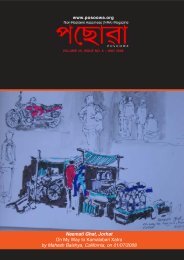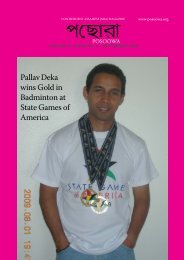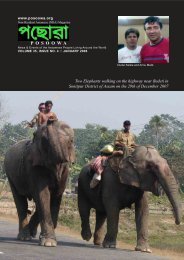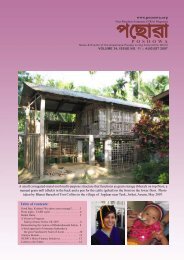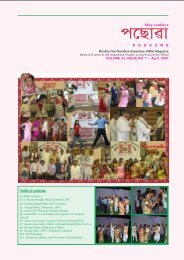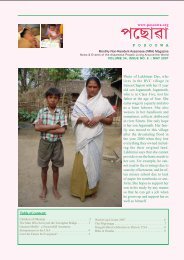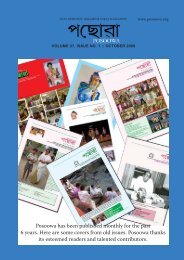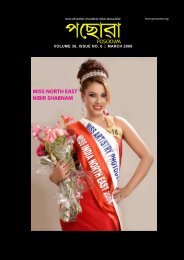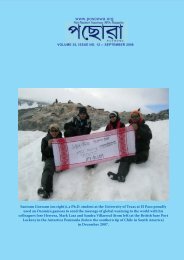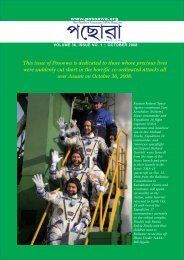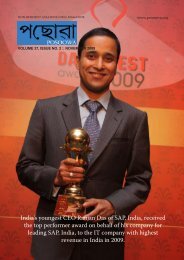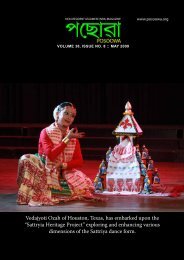Volume 35, Issue 6, March 2008 - Posoowa
Volume 35, Issue 6, March 2008 - Posoowa
Volume 35, Issue 6, March 2008 - Posoowa
Create successful ePaper yourself
Turn your PDF publications into a flip-book with our unique Google optimized e-Paper software.
Bar Amar: Ahom Dictionary<br />
We, a group of five relatives,<br />
were to make an informal call<br />
at the residence of Shri<br />
Lokam Tumung, the headman of<br />
Kharang Kong, a Tangsa village while<br />
we were on a visit to Margherita, Ledo<br />
and other places in Assam. Actually, our<br />
host was ready for us after he got our<br />
phone call that we were on our way. We<br />
also met two other chiefs there, namely,<br />
Shri Yanim Mochang and Shri Kamsat<br />
Loongvi. There was one more person<br />
who also looked like a chief with the<br />
usual headgear, a colorful lungi and<br />
other bits of tribal haute couture,<br />
although he looked a little different from<br />
the rest. His ruddy white complexion in<br />
a much younger body betrayed him. He<br />
was no other than the Australian linguist<br />
Dr Stephen Morey. Dr Morey completed<br />
his Ph.D. on the Tai language of Assam<br />
in 2002. Ever since he has been engaged<br />
in the study of the languages of the<br />
Northeast of India.<br />
We exchanged gifts. The tea served to<br />
us all was delicious. While munching<br />
biscuits and other savories, we<br />
abandoned European civility and put<br />
personal questions to Stephen; he<br />
responded to without taking offence.<br />
Yes, he was married. He did not cook,<br />
as his host would not allow him to do<br />
so. He spoke Tangsa only with the<br />
inmates of the house as well as with<br />
other villagers. He hopped on a bicycle<br />
from one village to the other dressed like<br />
a local Tangsa man.<br />
We asked him about his work. He gave<br />
us his card and a leaflet, which DOBES<br />
Page 10, recto of 1795 edition<br />
produced. DOBES stands for<br />
Dokumentation Bedrohter Sprachen; the<br />
acronym may not be precise, which<br />
means Documentation of Endangered<br />
Languages. Tangsa, Tai and Singpho are<br />
named in the leaflet among other extinct<br />
languages, in all about fifty.<br />
I asked him questions, which were more<br />
in anthropology than in linguistics.<br />
Since these subjects correlate, Stephen<br />
was able to answer them precisely and<br />
with authority.<br />
The word Tangsa is a derivative from<br />
the word Tong that means high land.<br />
‘Cha’ or ‘Sa’ means sons of the high<br />
land. Like the Ahoms, they migrated<br />
from the South-West China province of<br />
Yunan through Burma and settled in the<br />
Dehing-Patkai region in the 13 th century.<br />
While discussing about the Tangsa,<br />
Stephen casually mentioned the Tai-<br />
Ahom language and the research that is<br />
going on.<br />
Later, after my return to UK, I checked and<br />
found that Dr. Stephen Moray is the Director<br />
of the Ahom Dictionary Resource Project.<br />
Bar Amar (1785) is the most important<br />
Ahom language reference source. There are<br />
several versions of this invaluable document<br />
and the version considered to be the most<br />
reliable is now preserved carefully at the<br />
Department of Historical and Antiquarian<br />
Studies (DHAS) at Guwahati. The<br />
manuscript is being edited with up-to-date<br />
annotations by Yehom Buragohain who is<br />
in charge of the Ahom Section in DHAS.<br />
A veteran Ahom scholar, Junaram<br />
Sangbun Phukan of Patsako, Sivasagar,<br />
Assam possesses a sasi bark manuscript<br />
that contains nearly 3,000 entries. This<br />
is considered to be more accessible to<br />
scholars and is being now<br />
photographed, transcribed and<br />
translated under the aegis of the CRCL<br />
(Centre for Research in Communication<br />
and Language), at the Stirling<br />
University. The Department of<br />
Dr Stephen Morey<br />
Linguistics of the Gauhati University is<br />
also associated with this project.<br />
A more detailed account of the project<br />
can be found on this site:<br />
sealang.net/archives/ahom that explains<br />
why research on the Ahom language is<br />
significant. Not long ago there was an<br />
outcry in the Assam press that hundreds<br />
of manuscripts in DHAS’s archives<br />
were decaying for lack of expert care.<br />
Another criticism was that the progress<br />
in linguistic research in the Northeast<br />
had been tardy. One can only hope that<br />
things are now getting better.<br />
Bhuban Baruah, UK<br />
Page 3 * POSOOWA, <strong>March</strong> <strong>2008</strong>



